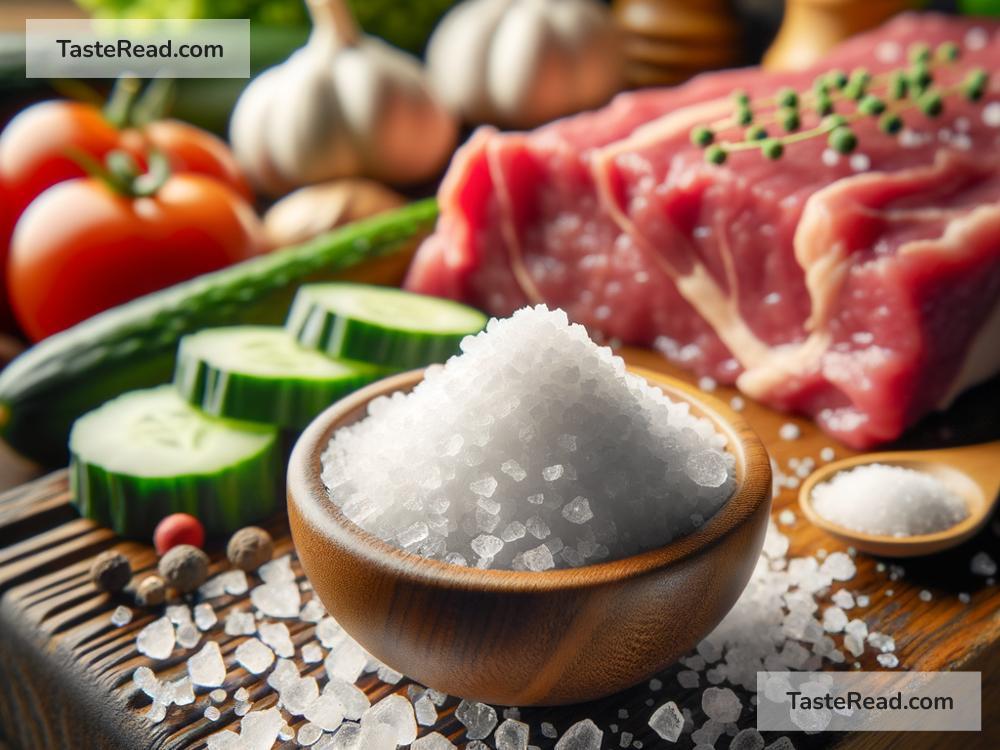How Salt Affects Flavor and Preservation
Salt is one of the most important ingredients in cooking and food preservation. It’s something almost everyone has in their kitchen, but have you ever stopped to think about why salt is so special? In this blog, we’ll look at how salt impacts flavor and helps preserve food, using simple language so that anyone can understand.
What Is Salt?
Salt is a mineral made up of two elements: sodium and chloride. The salt we use in cooking usually comes from salt mines or seawater. While it might seem like a basic ingredient, salt plays a vital role in both the flavor and safety of our food.
How Salt Affects Flavor
Salt is known as a “flavor enhancer,” which means it makes food taste better. But how does it do that?
-
Bringing Out Natural Flavors
When you add salt to food, it helps bring out its natural flavors by balancing sweetness, bitterness, and acidity. For example, adding a pinch of salt to a sweet dessert like chocolate increases the richness of the flavor. Similarly, adding salt to bitter vegetables like kale can make them taste less sharp. -
Reducing Bitterness
Salt can soften bitter flavors, making certain foods more enjoyable. Think of coffee or dark chocolate—if they have too much bitterness, adding a bit of salt can tone it down. -
Balancing Sweetness and Sourness
In dishes like soups, sauces, or even fruits, salt helps balance different tastes. Imagine eating watermelon with a sprinkle of salt—it enhances its sweetness and creates a new flavor sensation. -
Improving Texture in Some Foods
Salt also affects the texture of foods, especially in baking. For instance, salt strengthens gluten in bread dough, making the bread less crumbly and more chewy.
While salt makes food taste better, it’s important to be careful about how much you use. Too little, and your food will taste bland. Too much, and it might become overly salty and unpleasant.
How Salt Preserves Food
Salt isn’t just important to taste—it’s also been used for centuries to keep food from spoiling. Long before refrigerators were invented, people relied on salt to preserve meat, fish, and vegetables. Here’s how salt protects food from going bad:
- Drawing Out Moisture
One of the main reasons food spoils is because bacteria and microbes thrive in moist environments. Salt works by drawing water out of food and away from bacteria, keeping the food dry and less likely to rot. This process is called “osmosis.”
For example, salted fish or cured meats are dried out by the salt, helping them last for weeks or even months without refrigeration.
-
Creating a Harsh Environment for Microbes
Salt also creates an environment that is hostile to bacteria and fungi. These microbes need water to grow, so the dryness caused by salt makes it hard for them to survive. Some bacteria can tolerate salt, but most harmful microbes are stopped in their tracks. -
Fermentation Control
In foods like pickles, kimchi, or sauerkraut, salt is used not only to preserve but also to encourage fermentation. Fermentation involves “good” bacteria that thrive in salty environments and produce tasty, tangy flavors. Salt helps these friendly microbes succeed while keeping harmful ones out. -
Preserving Color and Texture
Salt can help foods keep their original color and texture for a longer time. For example, when vegetables are salted before pickling, their crispness is preserved.
Types of Salt and Their Uses
Did you know there are different kinds of salt, each suited for particular tasks? Let’s look at a few common types:
- Table Salt: The most basic type. It’s fine and easy to sprinkle. Great for everyday cooking.
- Sea Salt: Comes from evaporated seawater. It’s known for its mineral content and briny flavor.
- Kosher Salt: Larger crystals make it easier to pinch and sprinkle during cooking. It’s popular for seasoning meats.
- Rock or Himalayan Salt: Often used as a finishing salt or for its unique taste and mineral benefits.
- Pickling Salt: Specially made for preserving foods—it dissolves easily and doesn’t contain additives.
Each type of salt has a different texture, flavor, and purpose, making it important to choose the right kind for your recipe.
A Balancing Act
Salt is a wonderful and powerful ingredient, but it should be used with care. Eating too much salt can lead to health problems, such as high blood pressure. On the other hand, if you eat too little salt, your body can struggle to function properly, as it needs sodium for things like muscle movement and hydration. The key is balance—enough to enhance flavor and preserve food, but not so much that it harms your health.
Conclusion
Salt is more than just a seasoning—it’s a tool that helps chefs and home cooks make food taste delicious while also keeping it safe and fresh. It brings out the best in flavors, reduces bitterness, balances sweetness and sourness, and supports food preservation by drying out moisture and stopping harmful bacteria.
Whether you’re sprinkling salt over your dinner or curing meat for storage, take a moment to appreciate what salt does. This tiny mineral makes a big impact on how we enjoy and store the foods we love. So, the next time you reach for your salt shaker, remember you’re holding one of the most essential ingredients in human history!


